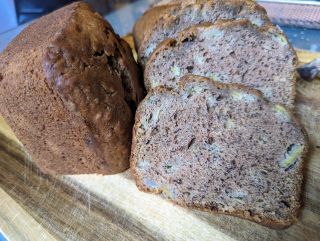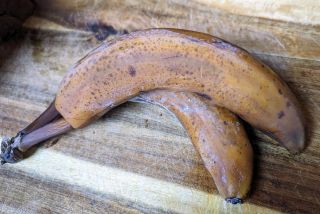Beauty
I’m Beautiful, Banana Bread!
Mushy, overripe bananas make this recipe delicious.
Posted November 3, 2023 Reviewed by Gary Drevitch
Key points
- We can define beauty for ourselves rather than have others define it for us.
- We can look at beauty as something that brings us to the essence of who we are.
- Things we might discard, like overripe bananas, bring deliciousness to our I'm Beautiful Banana Bread recipe.

The other day I started to look at photos from college. While perusing them, I was struck by the thought of looking better than I remembered thinking I looked at that time. There was a lot of self-consciousness during those days. As I shuffled through the photos, it was perplexing as to why I ever thought this. The realization made me feel sad, a sad that was like a sense of loss. I could have felt good about myself rather than doubtful; a sense of doubt that took away from potential moments of joy at that time.
This experience made me think about beauty and how we define it. What is beauty anyway? What was it in my young adult environment that made me feel insecure? How do we learn about beauty?
A couple of weeks ago my 7-year-old son Olliver and I watched the movie Nanny McPhee. The plot focuses on Nanny McPhee, a caregiver with magical powers. She shows up to work with a family whose children are disruptive and need support. Nanny McPhee’s appearance strikes silence when she arrives. Her face is covered with large warts and a prominent protruding front tooth makes it hard to see her mouth. Each time one of the children in Nanny McPhee's care demonstrates a positive change based on a life lesson, one of these aspects of her appearance vanishes. Not necessarily in this order, but a wart disappears, then another, then the front tooth… this continues throughout until, in the end, Nanny McPhee looks like Emma Thompson, the actor who plays the part. The quirks that in part make Nanny McPhee so different from any other caregiver are gone.
While watching these changes and as the movie neared its end, Olliver turned to me and said, “I liked Nanny McPhee better before, she seemed more herself.”
I loved Olliver’s comment. I so appreciated that for him, the changes that could be considered as moving toward an idealized idea of beauty actually took away from the person’s being, the true sense of who that person was.
This made me think about how it’s so often the case that when we think about beauty, we think about transforming into something else, rather than moving into being ourselves.
Can we look at beauty not as something we strive toward, but instead as something that brings us back to the essence of who we are?
Another beauty moment arose this past weekend. This time it was about me, not Nanny McPhee. And this time it was Olliver who was looking at old photos; memories of his older sisters and I when they were 3 and 5. Now they’re 18 and 20, so we’re talking about 15 years ago.
“Mama,” said Olliver, as he examined the photos thoughtfully. I inhaled. His inflection meant he had an opinion to share.
“Mama,” he emphasized, “you look funny in these photos.”
“What do you mean by funny?” I asked, annoyed that I was anxious to hear the answer. After all, I was 15 years younger.
“Well,” Olliver slowly responded, thinking, “you don’t look like yourself. You don’t look like how you look now. You look different from my mom. I like the way you look now better than then.”
Big exhale.
Maybe beauty is about truly and authentically embracing ourselves and all the parts that entails — the warts and protruding teeth, to use Nanny McPhee as a reference, that make us who we are.

And in that acknowledgement of who we are, we can acknowledge to ourselves that no one gets to define our beauty. We define it for ourselves. And in defining it for ourselves, perhaps we can expand our perspective about what we see as beautiful. While I worried that age might make me less beautiful, what I learned from Olliver was that it made me who I am today. And that’s a beautiful thing!
In committing to our own definition of beauty, I’m hopeful that we can see it in ways we haven’t before, and to explore beauty beyond the confines of how mainstream society might define it. To look for beauty in ways that it might be overlooked. The beauty of a birthmark, for instance, that is unique to the individual. The beauty of an elderly person with a historical perspective to share. The beauty of a surgical scar that denotes surviving a disease.

One example in food is the beauty of the mushy (overripe is the term my chef husband Julian would use) banana. How many times have we discarded things we perceive as mushy when in fact, part of the beauty of the mushy banana is the delicious, fresh taste it brings to our banana bread.
What overlooked aspects of beauty do we miss in our day-to-day lives? We invite you to explore for yourself as you make this recipe.
And as we make it, we can say, “I am beautiful, banana bread!”
I’m Beautiful Banana Bread
(In our book, we add 1/2 cup semisweet chocolate chips and call it Izzy’s Banana Chocolate Bread.)
Ingredients
½ cup unsalted butter
4 large ripe bananas
1/4 cup vegetable oil
2 large eggs
1 tsp vanilla extract
2 cups all-purpose or whole wheat flour
1/2 cup granulated sugar
1/2 cup packed soft brown sugar
1 tsp baking soda
1/2 tsp ground cinnamon
1/2 tsp fine sea salt
1/2 cup toasted chopped almonds, walnuts, or pecans (optional)
Makes 1 loaf.
Directions
Preheat the oven to 350 degrees F.
Spray the inside of a 9-x-5-inch loaf pan with nonstick cooking spray or line it with parchment paper (either option works well).
In a small saucepan over low heat (or in the microwave), melt the butter. In a medium bowl, mash together the bananas, melted butter, and vegetable oil. Add the eggs and vanilla and mix well.
In a large bowl, mix the flour, granulated sugar, brown sugar, baking soda, cinnamon, salt, and nuts, if using.
Add the wet ingredients to the dry ingredients and mix with a rubber spatula until all your ingredients are just combined. Do not overmix, as this will make your bread chewy or tough.
Pour the batter into the loaf pan and level off the top with your spatula. Bake for 45 to 55 minutes. You can test your bread by inserting a wooden toothpick into the center of your bread. If it comes out clean, it’s ready.
Remove from the oven and allow the banana bread to cool and set for about 15 minutes. Then turn over the loaf pan onto a cutting board and gently shake the pan until the banana bread comes free. Remove the parchment paper if necessary.
Serve your banana bread warm or cold.
Beautiful!
References
Clauss-Ehlers, J.C.E., & Clauss-Ehlers, C.S. 92022). Eating together being together: Recipes, activities, and advice from a chef dad and psychologist mom. Princeton Architectural Press.




